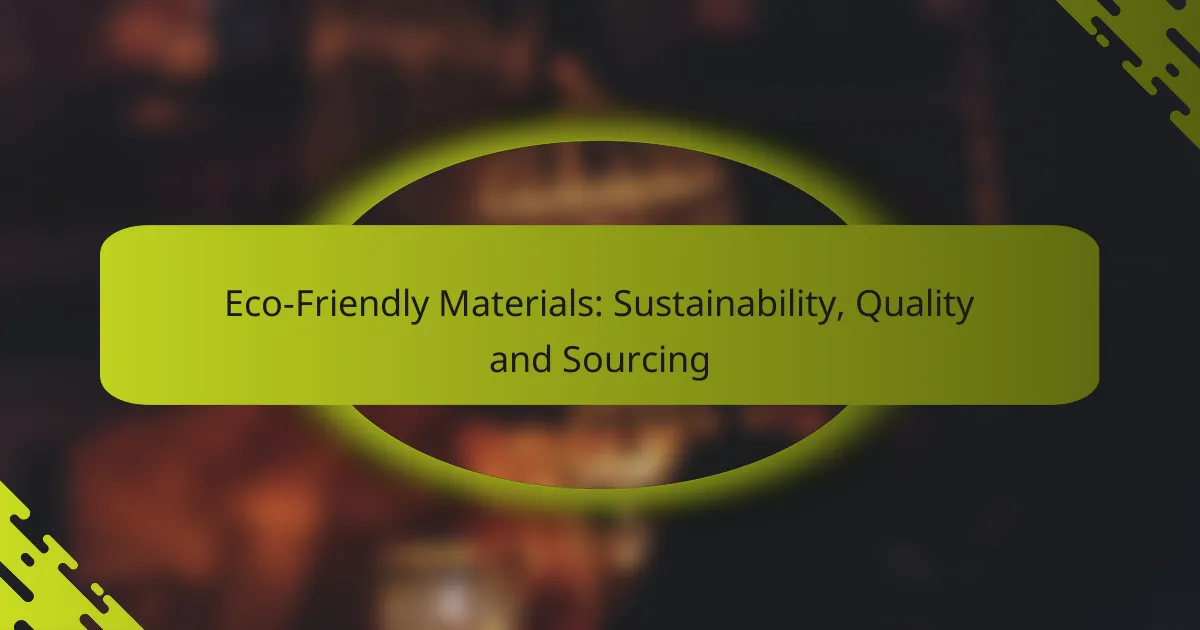Eco-friendly materials play a crucial role in promoting sustainability by minimizing environmental impact throughout their lifecycle. Responsibly sourced and often biodegradable or recyclable, these materials not only reduce waste but also offer quality alternatives to conventional products, ensuring a positive effect on ecosystems. Adhering to quality standards helps consumers make informed choices, fostering responsible consumption and supporting ethical sourcing practices.

What are eco-friendly materials for sustainable living?
Eco-friendly materials for sustainable living are products that minimize environmental impact throughout their lifecycle. These materials are sourced responsibly, produced with low energy consumption, and often biodegradable or recyclable, making them ideal for reducing waste and conserving resources.
Bamboo
Bamboo is a fast-growing grass that can be harvested sustainably, making it an excellent eco-friendly material. It requires minimal water and no pesticides, which reduces its environmental footprint. Commonly used in furniture, flooring, and textiles, bamboo products are durable and often biodegradable.
When choosing bamboo items, look for certifications like FSC (Forest Stewardship Council) to ensure responsible sourcing. Avoid products that use harmful chemicals in processing, as these can negate bamboo’s eco-friendly benefits.
Recycled plastics
Recycled plastics are materials repurposed from post-consumer waste, significantly reducing the need for new plastic production. This process helps divert waste from landfills and lowers greenhouse gas emissions associated with plastic manufacturing. Common applications include containers, textiles, and construction materials.
When purchasing products made from recycled plastics, check for labels indicating the percentage of recycled content. Aim for items that use high-quality recycled plastics, as these tend to be more durable and have a longer lifespan.
Organic cotton
Organic cotton is grown without synthetic pesticides or fertilizers, making it a healthier choice for the environment and farmers. This type of cotton uses crop rotation and natural pest control methods, which enhance soil health and biodiversity. It is commonly found in clothing, bedding, and towels.
Look for certifications such as GOTS (Global Organic Textile Standard) when buying organic cotton products. These certifications ensure that the cotton is grown and processed according to strict environmental and social criteria.
Hemp
Hemp is a versatile plant that grows quickly and requires little water or pesticides, making it an eco-friendly option. It can be used in textiles, paper, and building materials. Hemp fibers are strong and durable, often outperforming cotton in terms of longevity.
When selecting hemp products, consider those that are certified organic to ensure sustainable farming practices. Hemp’s low environmental impact makes it a great choice for various applications, from clothing to biodegradable plastics.
Cork
Cork is harvested from the bark of cork oak trees without harming the tree, allowing it to regenerate. This sustainable harvesting method makes cork a renewable resource. It is commonly used in flooring, insulation, and wine stoppers due to its unique properties, such as being lightweight and water-resistant.
When choosing cork products, look for those that are certified by organizations like the FSC. Cork’s natural qualities and sustainable sourcing make it an excellent choice for eco-friendly living.

How do eco-friendly materials impact sustainability?
Eco-friendly materials significantly enhance sustainability by reducing environmental harm and promoting resource conservation. These materials are designed to minimize negative impacts on ecosystems while providing quality alternatives to conventional products.
Reduced carbon footprint
Using eco-friendly materials often leads to a reduced carbon footprint, as they typically require less energy to produce and transport. For instance, materials like bamboo and recycled metals can be sourced locally, cutting down on emissions associated with long-distance shipping.
When selecting products, look for certifications such as Energy Star or LEED, which indicate lower carbon outputs. Choosing items made from renewable resources can further contribute to a smaller carbon footprint.
Conservation of resources
Eco-friendly materials promote the conservation of natural resources by utilizing sustainable practices in their production. For example, organic cotton uses less water and avoids harmful pesticides, making it a more resource-efficient choice compared to conventional cotton.
Consider products made from recycled materials, which help reduce the demand for virgin resources. This not only conserves raw materials but also minimizes waste in landfills.
Biodegradability
Biodegradable materials break down naturally over time, reducing landfill waste and pollution. Products made from materials like cornstarch or certain types of paper can decompose within months, unlike traditional plastics that may take hundreds of years.
When purchasing, look for labels that indicate biodegradability or compostability. This ensures that the products will not contribute to long-term environmental damage after their useful life has ended.

What are the quality standards for eco-friendly materials?
Quality standards for eco-friendly materials ensure that products are sustainable, safe, and ethically sourced. These standards help consumers identify materials that meet specific environmental and social criteria, promoting responsible consumption.
Global Organic Textile Standard (GOTS)
The Global Organic Textile Standard (GOTS) is a leading certification for organic textiles. It covers the entire supply chain, from the harvesting of raw materials to manufacturing processes, ensuring that textiles are made from at least 70% organic fibers.
GOTS also mandates strict environmental and social criteria, including safe working conditions and fair wages for workers. Products that carry the GOTS label are recognized for their commitment to sustainability and ethical practices.
OEKO-TEX certification
OEKO-TEX certification is a globally recognized standard for textile safety and sustainability. It ensures that textiles are free from harmful substances and safe for human health, with various classes addressing different levels of product safety.
Textiles with OEKO-TEX certification are tested for harmful chemicals, including pesticides and heavy metals. This certification is particularly important for products intended for children or sensitive skin, providing peace of mind to consumers.
FSC certification
The Forest Stewardship Council (FSC) certification ensures that wood and paper products come from responsibly managed forests. This certification promotes sustainable forestry practices that protect biodiversity and the rights of local communities.
FSC-certified materials are traceable from the forest to the final product, allowing consumers to make informed choices. When purchasing products made from wood or paper, look for the FSC label to support sustainable sourcing.

Where to source eco-friendly materials in North America?
North America offers various options for sourcing eco-friendly materials, including local suppliers, online marketplaces, and eco-conscious brands. Each avenue presents unique benefits and considerations for sustainable sourcing.
Local suppliers
Local suppliers are often the best option for sourcing eco-friendly materials, as they typically offer products that are produced with minimal environmental impact. By purchasing locally, you can reduce transportation emissions and support regional economies.
When seeking local suppliers, consider visiting farmers’ markets, craft fairs, or specialty stores that focus on sustainable goods. Engaging with suppliers directly can also provide insights into their sourcing practices and material quality.
Online marketplaces
Online marketplaces provide a convenient way to access a wide range of eco-friendly materials from various vendors. Websites like Etsy, Amazon, and specialized eco-friendly platforms allow you to compare products, prices, and sustainability certifications.
When using online marketplaces, look for sellers who provide detailed information about their materials’ origins and environmental impact. Reading reviews and checking for certifications can help ensure that you are making responsible purchases.
Eco-conscious brands
Eco-conscious brands focus on sustainability throughout their supply chains, offering products made from recycled, organic, or renewable materials. These brands often prioritize ethical labor practices and transparency in their sourcing methods.
Researching and supporting eco-conscious brands can lead to high-quality materials that align with your sustainability goals. Look for brands that are certified by recognized organizations, such as the Forest Stewardship Council (FSC) or Global Organic Textile Standard (GOTS), to ensure their commitment to eco-friendly practices.

What are the benefits of using eco-friendly materials in products?
Using eco-friendly materials in products offers numerous advantages, including reduced environmental impact, improved health safety, and enhanced brand reputation. These materials often come from renewable resources and can be recycled or biodegradable, contributing to sustainability efforts.
Sustainability and Environmental Impact
Eco-friendly materials significantly lower the carbon footprint of products by minimizing resource depletion and pollution. For instance, materials like bamboo and organic cotton require less water and pesticides compared to conventional options. Choosing sustainable materials helps preserve ecosystems and reduces waste in landfills.
Quality and Durability
Many eco-friendly materials are not only sustainable but also high-quality and durable. For example, recycled plastics can be engineered to meet or exceed the performance of virgin materials. Investing in these materials can lead to longer-lasting products, reducing the need for frequent replacements.
Sourcing and Ethical Considerations
Sourcing eco-friendly materials often involves ethical practices that support fair labor and local economies. Companies can choose suppliers who adhere to sustainable practices and certifications, such as Fair Trade or Global Organic Textile Standard (GOTS). This approach not only benefits the environment but also fosters social responsibility.










